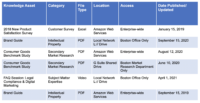
How to Develop a Knowledge Management Strategy for Your Enterprise
Did it take more than a little knowledge to build your enterprise into the powerhouse it is today? I expect that to build your business it took an extensive amount of market research across primary, secondary sources, third party subscriptions, industry news, internal research, analyst reports. I also expect that over the years, your organization has cached an extensive collection of knowledge assets, from policies and procedures, intellectual property, market research, and consumer and competitor intelligence to social data, subscription services, business news, and everything in between. They say knowledge is power, but that’s not the whole story; in fact, an enterprise is only as powerful as its knowledge management strategy. After all, what good is all that knowledge if it isn’t effectively democratized, defragmented, and leveraged across your organization?
A knowledge management strategy is a documented plan of action to meet an organization’s needs and goals related to organizing its knowledge assets, closing knowledge gaps, and managing knowledge. A knowledge management platform is an essential tool that allows you to streamline your organization’s resources and helps you measure the progress of your knowledge management strategy along the way.
Ready to develop your organization’s actionable plan? Follow this 5–step process for developing a winning knowledge management strategy.
1. Inventory Existing Knowledge Assets & Management Processes
Take inventory of your current knowledge management processes. Start by identifying the locations where your documented knowledge assets are housed, such as a shared drive, company intranet, knowledge management platform, or a real-time chat platform. You’ll need to consider your undocumented knowledge assets as well, such as the expertise of your subject matter experts. This type of asset can be challenging to catalog, but sending out an employee survey that asks employees to identify their specialized knowledge and skills can help. Take a look at the example below to help you sort your assets by their relevant identifiers, such as the document’s category, file type, location, access details, and when it was published or last updated.

2. Identify Knowledge Gaps & Knowledge Management Challenges
Once you know what and where your knowledge assets are, it will be easier to assess your organization’s knowledge gaps and other knowledge management challenges. Take a look at the example inventory chart above. Only the Boston office has access to the legal compliance resource for digital marketing, but employees in other offices should have access to this resource as well. It’s also readily apparent that more than one version of the brand guide exists. That issue is also exacerbated by the fact that the latest version was saved to a local network drive, meaning employees working in other locations do not have access to the latest logo, color scheme, and marketing strategy. There are also several shared drives, which means management and employees are likely wasting time searching for what they need, relying on outdated information, or avoiding the search altogether to avoid the difficulties. The secondary research study was stored in a shared file that’s only accessible to the market research department in the Boston office. Unfortunately, it appears the head of a different department approved a purchase requisition for the exact same study about two months later.
Essentially, a knowledge gap or challenge is the result of an unmet need. Your knowledge asset inventory will yield valuable information, but you can also glean critical insights from your department leaders and staff. By using employee surveys, you can get a better grasp of how employees feel about your organization’s communication and level of collaboration. You can also ask how confident they are that they can (a) find the information they need and (b) rely on it to be accurate and current.
3. Set Goals Based on Your Enterprise’s Knowledge Management Needs
Your enterprise’s needs will guide you in setting your knowledge management goals. If your leaders are not consulting relevant data and insights, your organization could suffer costly consequences. Your leadership may avoid searching for existing data and insights ahead of making key business decisions if the search process is too difficult or time-consuming. A corresponding goal, in this case, would be to implement a central location that has advanced search capabilities. If your employees or departments are duplicating work efforts, one of your enterprise’s goals might be to break down communication silos and increase enterprise-wide collaboration. When your subject matter experts are overrun with information requests and repeat questions, your enterprise’s corresponding goal might be to find a platform that allows users to upload all file types, so your subject matter experts can post insights, FAQ documents, or video tutorials in a central location.
Once your goals are established, it’s time to formally document your knowledge management strategy and guidelines for your employees ahead of the implementation process. Assign realistic and manageable timelines for completing your goals. And think about establishing a test group, so you can pilot a program before you license it. You’ll want to map out platform training and use expectations, such as expected content contributions.
4. Encourage Enterprise-Wide Adoption of Your Strategy & Knowledge Management Platform
For your knowledge management strategy to be successful, it’s essential to get everyone on board. To insight enterprise-wide adoption of a new platform, you will need a strong launch campaign. Consider including employee alerts, training videos, and even testimonies of the platform’s effectiveness. Elect a leader with decision-making authority from each affected department to spearhead implementation, provide employees with guidance, and encourage adoption of your strategy, including appropriate use of your knowledge management platform. Your employees rely on you to provide them with the information they need to do their jobs. If that information is out-of-date, or if they are wasting time trying to track down new information, your enterprise is in need of a knowledge management platform that resolves those problems.
With the right knowledge management platform, your organization can ensure enterprise-wide democratization of knowledge assets, whether originating in-house or through your secondary subscriptions and sources. You can speed up and enhance your processes for market research, finding insights on competitors and consumer trends, assessing growth opportunities, and developing new products. And, when everyone does their best to follow the strategy and uses the knowledge management platform appropriately, you’re going to see some impressive results.
5. Measure the Success of Your Knowledge Management Strategy
Implementing your organization’s knowledge management strategy isn’t the end of the road. Tracking your strategy’s success is an important part of the process. Send out employee surveys to reassess where your employees are with previous challenges. Schedule maintenance reviews and brainstorming sessions along the way. And use your platform’s analytics, such as content uploads and active users, to help you determine if you’re on the right track. The most impactful measure of your strategy’s success should be the positive ROI you receive from your knowledge management platform.
Northern Light’s SinglePoint provides large organizations with a research-driven competitive advantage. Each portal comes standard with unlimited seats for enterprise-wide sharing. Our advanced search technology, optimized for business research, delivers any content you need to which you have rights, and uses machine learning algorithms to learn user preferences, automatically summarize relevant content, and notify users when pertinent new content becomes available.
SinglePoint helps organizations strengthen knowledge management by making information easy to find and use. Contact Northern Light today to find out how SinglePoint can help meet your enterprise’s knowledge management needs.
